To read more about Ascham and Elizabeth's relationship, and her rigorous studies under his advisement, please see my article An Education: The Shaping of Elizabeth I Through Childhood Events and Academic Pursuits, published exclusively at On the Tudor Trail.
 |
| Portrait of Elizabeth Tudor c. 1546, attributed to William Scrots. In the Royal Collection, residing in Windsor Castle. Picture acquired through Wikimedia Commons. Image public domain. |
Roger Ascham was in attendance at a dinner hosted by William Cecil in 1563. The conversation turned to the distressing news that some boys from Eton College had run away from school because they feared the brutal beatings of their teachers.Some of the dinner guests favored the longstanding practice of corporal punishment for pupils, but Cecil, among others agreed with the progressive Ascham that England should transition to a gentler form of education; an education that would be no less academically challenging, but more governed by positive reinforcement than negative. One of Ascham's greatest works, The Schoolmaster, first published posthumously in 1570, concerned the matter of Elizabethan education.
~BONUS~
On this Day in Elizabethan History...December 31st
 |
| Portrait of Robert Dudley, Earl of Leicester c. 1564. Picture acquired through Wikimedia Commons. Image public domain. |
And, in recognition of New Years, I will also share with you a very special gift that Elizabeth received from her beloved Earl of Leicester for the New Years celebrations of 1585:
"First, a sable skynne, the hedd and four feete of gold, fully garnished with dyamonds and rubyes of sundry sorts."-from Progresses of Queen Elizabeth by John Nichols
A Happy New Year to all my BeingBess readers! Your support of this site galvanizes me to keep doing what I am doing; I am so happy to share Elizabeth and her remarkable story with many people worldwide who love her as I do.
You truly are my "Pastyme with goode companye"
I wish for health, happiness, and safety for you and yours in 2012...and of course, much more Queen Elizabeth I in the coming year!
Sources:
Palliser, D.M. The Age of Elizabeth: England under the later Tudor's. Print.
Nichols, John. Progresses of Queen Elizabeth. Electronic.






